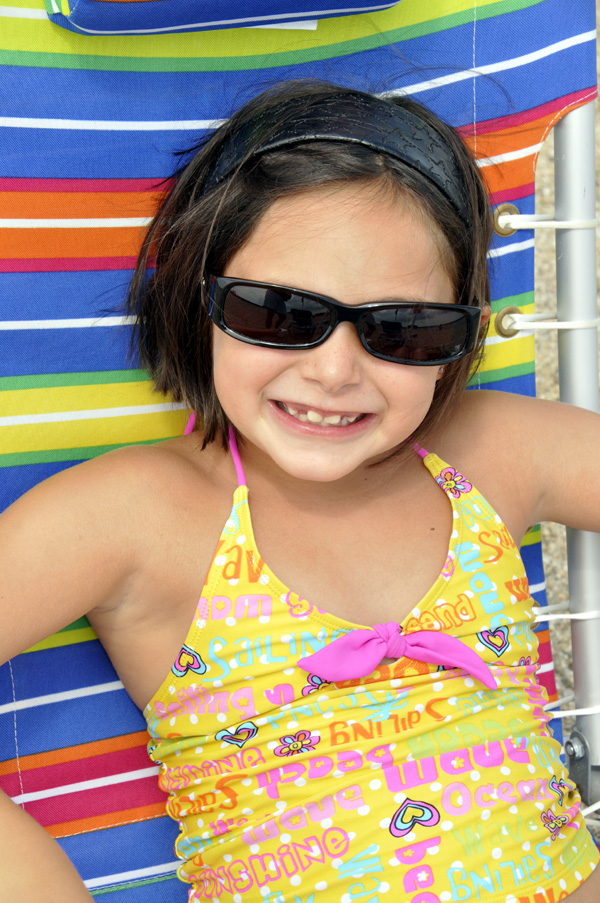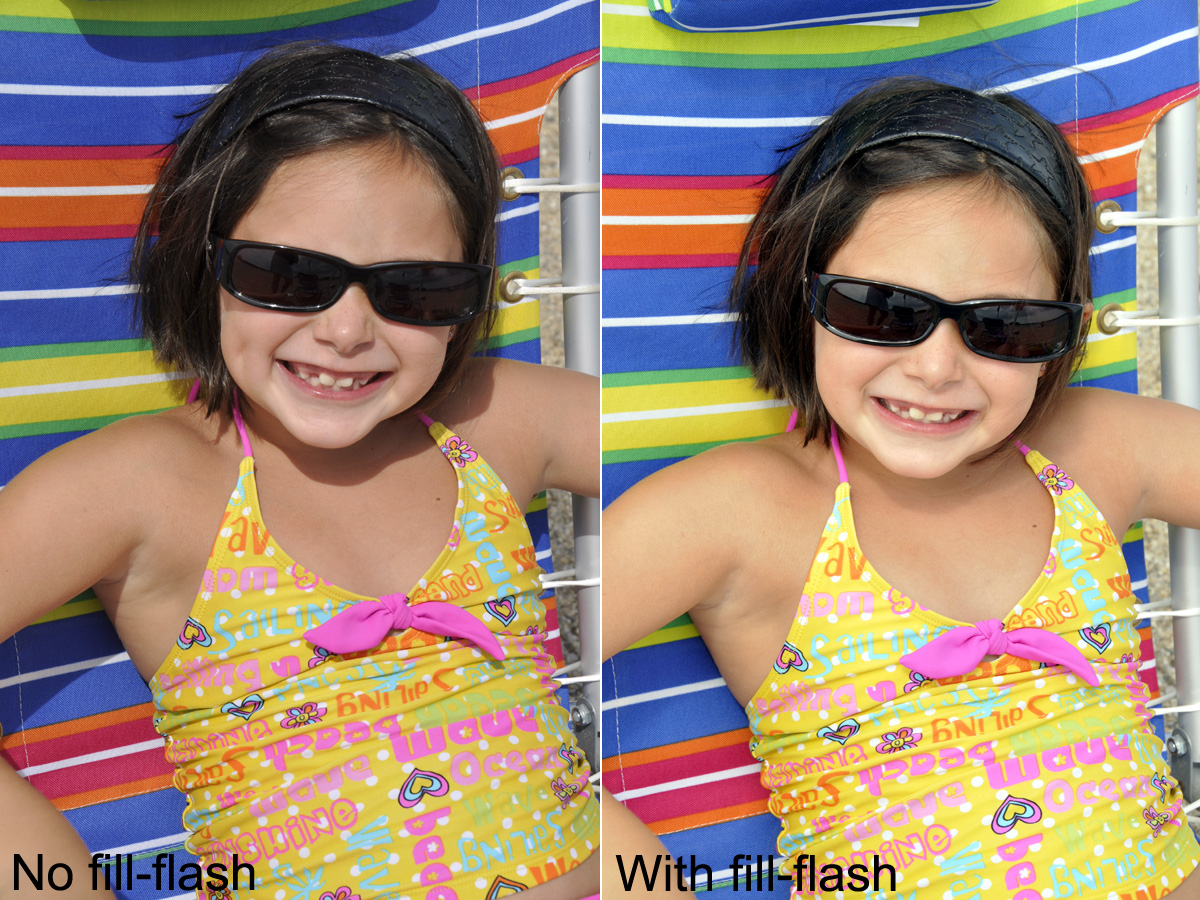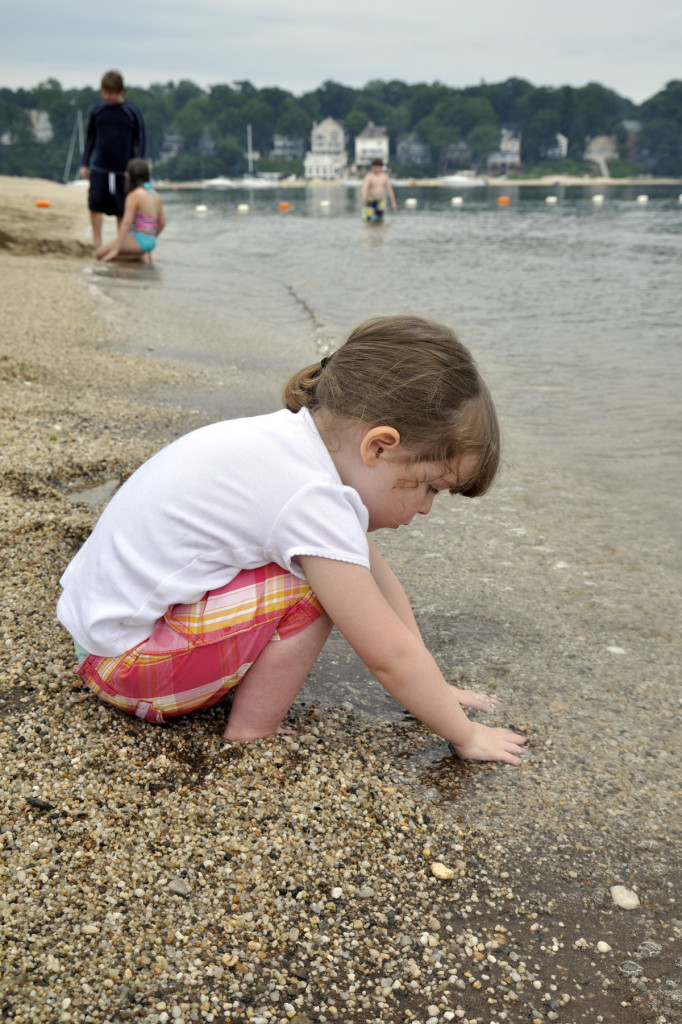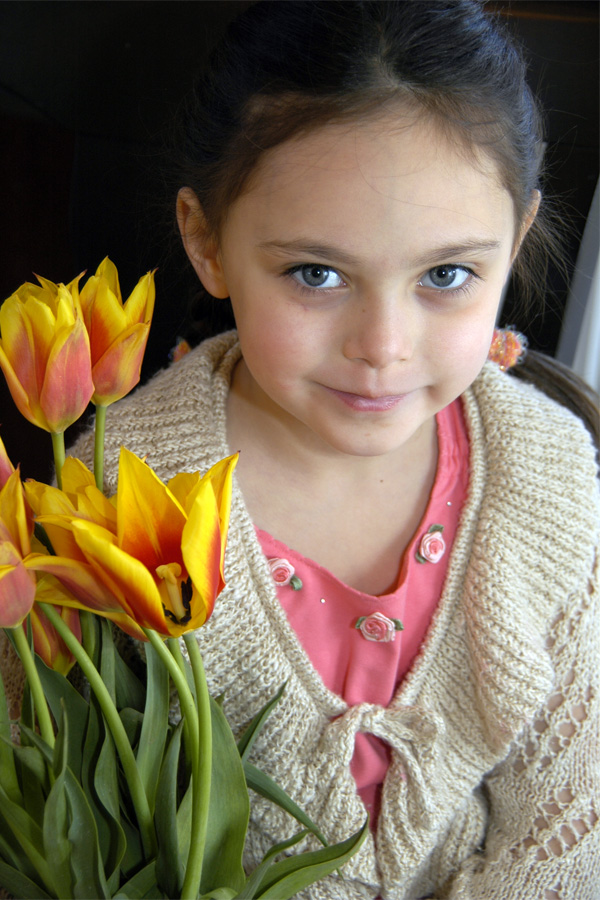Taking pictures at the beach is always fun (as long as you take a few precautions to protect your camera — see 7/6/11 post). But often we get harsh shadows that make the photos less desirable. Get rid of the harshness and raccoon eyes just by popping up your flash! Put your camera on the program mode (P) and pop-up your flash. As you can see in the example comparisons below, you can soften all of the harsh shadows. Examine the two photos. Look under the chair’s head rest, under the left arm, under the chin and below the rim of the sunglasses. Additionally, look at the sliver of rocky sand in the background on the right side. On the left, it’s sort of greyish, but on the right, it is a more pleasing color. Then look at the example further below (please ignore that toothless grinny expression!). In this case, the brightness behind the subject made the camera’s meter stop down a little (like putting on sunglasses because it was too bright) resulting in her face being too dark. But by popping up the flash, you see how you can brighten up a dark face. Tip: If you find the flash to be too bright or too artificial looking for your taste, then you can tone down the flash very simply. Look at the same button you use to pop up your flash. It should have a +/- symbol. Hold this button in and dial the wheel at your index finger to the right so that the numbers on your display go to the negative side. You are essentially subtracting power from the flash so that it puts out less light. Try several different settings (-0.7, -1.0, etc) until you achieve a desirable shot. You may need to consult your owner’s manual (yes, sorry) and look for “flash exposure compensation” in the index.
Tag Archives: fill flash
Grab Your Camera and a Towel and Head to the Beach for Fun Photos
It’s finally summer! And if your family’s like mine, beach figures heavily into the weekend. If you have young children that love to explore the beach, then get down on the sand with them. Make sure to bring a towel so that you can easily sit or even lay down close by in order to capture their explorations (and to keep sand on your hands to a minimum). Getting close and using a wide angle setting on your lens lets you show some more background to give a point of reference (see photos below). On bright sunny days, trying popping up your flash for some fill to eliminate harsh shadows from midday sun, and to add some light to your child’s face often hidden by cute sun hats. But don’t let cloudy days like we had here stop you form heading to the beach with your camera. The over cast sky is actually perfect for picture-taking. One note of caution: Salt water is an enemy of you camera. If the conditions are very “moist” on a hot hazy beach day, salt residue and water can collect on your camera and lens pretty quickly. Try putting your camera in a zip lock bag with a hole cut out for the front of the lens to stick out and be sure to use a UV filter. Clean the lens as soon as you can with lens cleaning fluid and a micro fiber cloth taking extra care to inspect for and remove any sand that may be on your lens before rubbing the lens. Then wash the cloth before using again after the beach. Store the camera back in your camera bag right after use to keep it out of the sun and elements. There are also special bags made for your camera to prevent any damage. Google rain coats for cameras.
"My Photo Are Too Dark" — Solutions for Common Problems: Part 2
In my last post (so long ago, I apologize but summer seemed to have gotten in the way), I covered easy solutions for blurry photos. The next most common problem is dark photos (i.e., under-exposed). While the most logical answer is there just is not enough light, there are other reasons for dark photos.
Problem: You are using the flash but the subject is still dark. Reason: The subject is too far away. The built-in flash on your camera can safely cover a distance of about 10 feet or so. If your subject is well beyond that, chances are it cannot be lit by your flash. Solution: The answer in this case would be to move a little closer. (You can also try raising your ISO to give your flash some more distance coverage).
Problem: The background is really bright and the camera’s meter is fooled. This is called a “back-lit” situation. The meters in today’s cameras are excellent, and you have the choice of several metering patterns to help you achieve your desired result. However, there are still situations like back-lit where you camera’s meter is fooled and gives you the wrong exposure for your subject. When the background is overly bright, the camera “puts on a pair of sunglasses” by closing the aperture down a little to let in less light, resulting in a nicely exposed background and a darker subject.
Examples of back lit situations:
- in front of a picture window
- at the beach or pool
- on snow
- when shooting from below up against a bright sky, etc.
- under an overhang (like a stadium with field in the background)
- The sun is behind your subject
Solution: 1 My favorite option is to use the + exposure compensation (covered here and here). This +/- button usually positioned near your thumb is one of my often used adjustments since you can quickly darken or lighten a subject. By adding (+) .3 to 1 full stop of light by dialing towards the plus side (see your instruction manual to see just how your camera works), you can trick your camera into removing the sunglasses and get a perfect exposure on your subject. By bracketing (taking several shots at several different exposure compensation settings) you are sure to get the proper exposure.
Solution 2: A second solution is to pop up the flash and fill in the subject.
Solution 3: Another way to get a good exposure in a precise area is to switch the camera’s metering pattern to spot metering. Most of the time, you are most likely shooting in the camera’s matrix mode that reads several areas of the image and gives you an exposure based on a lot of data built into the camera. This pattern works well much of the time. But the camera also has a center metering pattern where a smaller area is read and the exposure is based on that area. And even smaller sliver of the image can be measured by suing the spot metering mode (the rectangle with a small dot in the middle is the symbol for this pattern). Make sure the dot lays over the area of your subject you want properly exposed and then take the shot. If you need to recompose your image after taking the reading (dot on subject), then hold in the AE lock button located near the +/- button until you have finished taking the photo. Breaking out your camera’s instruction manual will give you the exact steps to set spot metering and to use AE lock.
In my example above (a perfect shot to end the summer), the child’s face my have been under-exposed, or dark, due to the brightness of the sky, surf and sand. But by adding 2/3-stop of light using the +/- feature, I was able to get a great exposure on her cute face.
Take a Candid Holiday Portrait by Window Light, and Add a Prop!
 The window is your best photo accessory for portraits. It’s so easy to use, always there, you don’t need an assistant to hold anything, and you don’t have to pull out your auxiliary flash. I just love the light that streams through my windows in several rooms. Positioning your subject very close to the window, like in the shot at left from early Easter mornning, can give you a nice dramatic light since the light falls off the opposite side of the face quickly and the eyes have a nice sparkle from the window catchlights. To get more of an even light, move your subject just a further away from the window (as in the first photo below- the subject was across the room from the window), or, face your subject perpendicular to the window instead of parallel. In this case, you can actually stand right in front of the window with your subject in turn in front of you and you will not block the light! See this post here for an example of this type of positioning. You can also “fill in” the other side of the face with a pop of the flash as you can see in the second photo below. If you find there is still a slight “artificial” feeling, you can adjust how much light the flash puts out by adjusting the flash +/- button usually found near the flash. Hold the button in and dial it towards the minus side. Perhaps -.7 or -1.0. Review the flash section in your camera manual to see exactly how to set this on your camera. And don’t foget to add a prop that gives your portrait a sense of time. In my case, the tulips scream spring and the eggs of course will remind me this was Easter time when we look back at these photos years from now. (Watch for a forthcoming download card with lighting diagrams for window light positioning).
The window is your best photo accessory for portraits. It’s so easy to use, always there, you don’t need an assistant to hold anything, and you don’t have to pull out your auxiliary flash. I just love the light that streams through my windows in several rooms. Positioning your subject very close to the window, like in the shot at left from early Easter mornning, can give you a nice dramatic light since the light falls off the opposite side of the face quickly and the eyes have a nice sparkle from the window catchlights. To get more of an even light, move your subject just a further away from the window (as in the first photo below- the subject was across the room from the window), or, face your subject perpendicular to the window instead of parallel. In this case, you can actually stand right in front of the window with your subject in turn in front of you and you will not block the light! See this post here for an example of this type of positioning. You can also “fill in” the other side of the face with a pop of the flash as you can see in the second photo below. If you find there is still a slight “artificial” feeling, you can adjust how much light the flash puts out by adjusting the flash +/- button usually found near the flash. Hold the button in and dial it towards the minus side. Perhaps -.7 or -1.0. Review the flash section in your camera manual to see exactly how to set this on your camera. And don’t foget to add a prop that gives your portrait a sense of time. In my case, the tulips scream spring and the eggs of course will remind me this was Easter time when we look back at these photos years from now. (Watch for a forthcoming download card with lighting diagrams for window light positioning).Use Your Flash for Outdoor Photos
We all have heard the rule that early morning and late afternoon are the magical times for talking photos. But let’s face it. At noon, we’re at the pool or the beach. Noon is when the action is happening and when we are more likely to be taking photos. So in order to avoid the raccoon eyes that come with overhead noon time light, just turn on your flash! The small burst of light will fill in shadows and make your subject’s eyes pop out just like it did for my subject. Look at the shot on the left with no flash. Harsh shadows fill in the eye sockets and the shadow is strong across her shoulder and neck. For the shot on the right, I just popped up my built-in flash and it makes a world of difference. To avoide over-exposing your subject, one trick is to dial in a small aperture like F/16 or F/22. For some people, images that use fill flash may appear to be too artificial. If you find the flash puts out too much light, there is a setting on most DSLR cameras whereby you can “compensate” the flash in a plus (+) or minus (-) direction. Dial in a -1 or -2 flash compensation and the flash will emit less light to fill in shadows more subtly. (For that tip, however, you will have to break out your camera manual to find the setting). So next time you’re at the pool or beach this summer, and you cannot get your subject under an umbrella, or tree or some other type of open shade during those harsh hours between 11am and 3pm, then try popping up your flash! (25mm; F/16; ISO200)
Scene Modes? They Really Do Work!
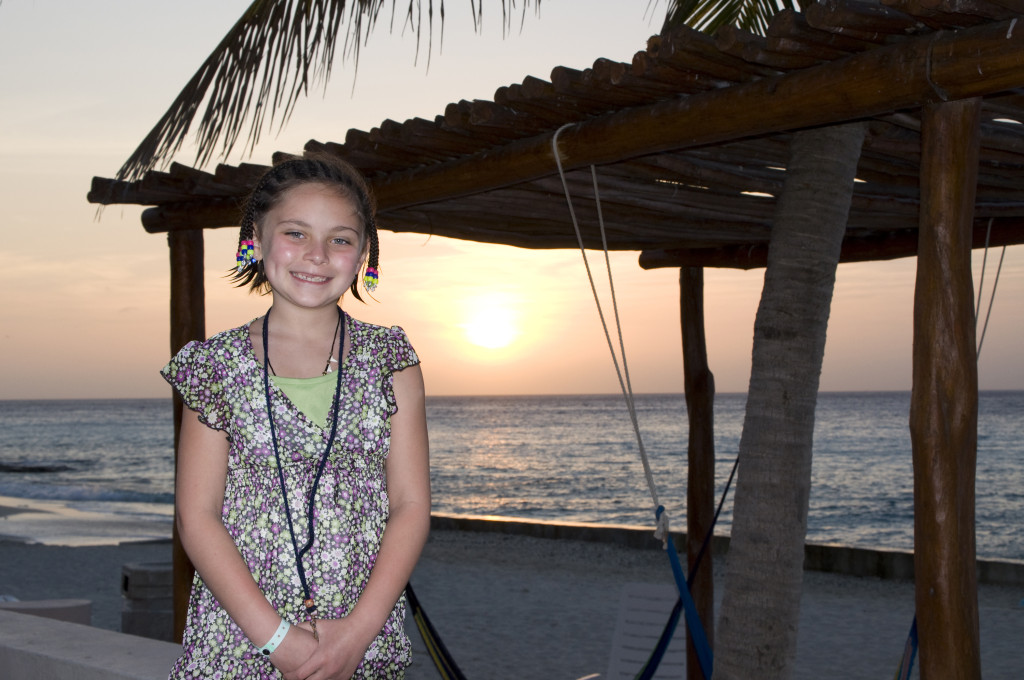
I really feel like I cheated to make this picture on our trip to Mexico last week! I used the “night portrait scene mode” instead of bracketing exposures and playing with the flash to get just the right balance of exposure on her while still having a nice sunset in the background. I had literally a few fleeting seconds of her attention before the sun set below the horizon. So I put the camera on a scene mode, which I never do! And guess what? I got one of the best sunset pictures of the trip!

